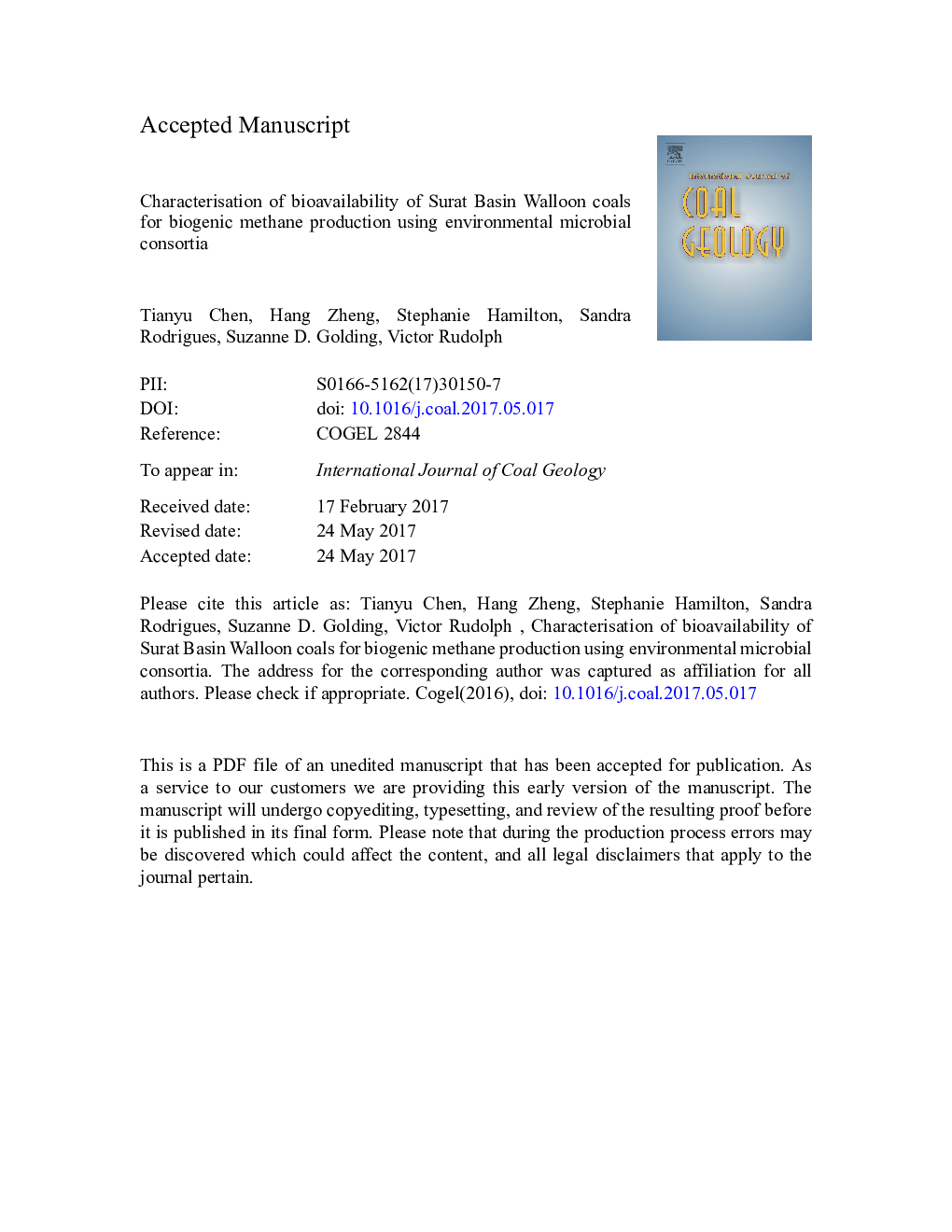| کد مقاله | کد نشریه | سال انتشار | مقاله انگلیسی | نسخه تمام متن |
|---|---|---|---|---|
| 5483621 | 1522524 | 2017 | 52 صفحه PDF | دانلود رایگان |
عنوان انگلیسی مقاله ISI
Characterisation of bioavailability of Surat Basin Walloon coals for biogenic methane production using environmental microbial consortia
ترجمه فارسی عنوان
ویژگی زیست پذیری از زغال سنگ والون سد حوضه سوات برای تولید متان زیستی با استفاده از کنسرسیوم میکروبی محیطی
دانلود مقاله + سفارش ترجمه
دانلود مقاله ISI انگلیسی
رایگان برای ایرانیان
موضوعات مرتبط
مهندسی و علوم پایه
علوم زمین و سیارات
زمین شناسی اقتصادی
چکیده انگلیسی
The study sets out to characterise the bioavailability of six Surat Basin Walloon coals from different stratigraphic layers in a single borehole to environmental methanogenic consortia. Factors that control bioavailability have also been investigated on grounds of coal petrographic composition and the organic composition of solvent-extractable matter. Finely crushed coal core samples were inoculated with digested sludge culture from domestic wastewater treatment in serum bottles kept anoxically before incubation at mesophilic temperature over 30 days for biomethane production. Degradation of coal compounds was demonstrated via GC-MS characterisation of methanol and dichloromethane (DCM) extracts, in combination with aqueous volatile fatty acids and alcohols and total organic carbon (TOC) analysis on fresh and microbially-digested coal samples. The resulting methane yields ranged from 14 to 33 μmol/g, with an average of 21 μmol/g (0.515 m3/t), comparable to those previously reported for subbituminous coals. Organic solvent-extractable materials that accounted for 3.8 to 12% of coal weight were generally dominated by aliphatic compounds, composed of mainly medium-long-chain n-alkanes, n-alcohols and esters. Aromatics were detected up to three fused rings, and are rich in dibenzofuran, alkyl benzene, diphenyls and alkyl PAH (polymeric aromatic hydrocarbon). The abundance of solvent-extractable matter was found to be positively associated with liptinite content, particularly suberinite, sporinite and liptodetrinite. Preservation of these compounds was thought to rely on vitrinite, such as telinite and collotelinite that are rich in micropores, serving as storage for the hydrocarbons. Environmental factors, such as microbe-carrying groundwater might compromise coal extractability by converting coal hydrocarbons to biogas. Bioavailability of coal was shown to be controlled by three factors: 1) Water solubility - Bioassay eliminated an average 98% of aqueous compounds (based on TOC), which were dominated by volatile fatty acids and alcohols, and to a lesser degree, medium-chain (primarily C10 to C20) n-alcohols, esters and aliphatic amine; 2) Solvent extractability - 34.5% of solvent-extractable compounds were shown to be biodegraded (based on peak intensity in GC-MS), with methanol extracts being more bioavailable than DCM's; 3) Heterogeneous moieties, particularly aliphatic hydroxyl group, ester bond, ether bond and CN bond in aliphatic amine - These functional groups present heteroatoms that can lower the activation energy of nearby bonds, making them vulnerable for microbial cleavage. Compound degradation in bioassays was shown to be clearly associated with methane yield, but only a small proportion degraded was converted to methane. Further improvement may be achieved via proper adaptation of the current microbial community.
ناشر
Database: Elsevier - ScienceDirect (ساینس دایرکت)
Journal: International Journal of Coal Geology - Volume 179, 15 June 2017, Pages 92-112
Journal: International Journal of Coal Geology - Volume 179, 15 June 2017, Pages 92-112
نویسندگان
Tianyu Chen, Hang Zheng, Stephanie Hamilton, Sandra Rodrigues, Suzanne D. Golding, Victor Rudolph,
